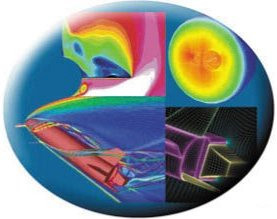

| Prof. Dr. rer. nat. Jochem Häuser | |
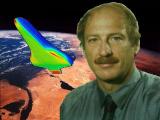 email: jh@hpcc-space.de email: jh@hpcc-space.de
Fon: +49 40 72 46 790 Fax: +49 40 72 40 103
Professor of Computer Science and Parallel Computing University of Applied Sciences, Braunschweig - Wolfenbüttel, Germany
and
Scientific Head, High Performance Computing and Communication
for Space
|
|
| Current Projects and Research Activities | |
| Plasma Modeling and Numerics | |
|
Numerical Solution of the magnetohydrodynamic equations for compressible high speed flows (U.S. contract)
|
|
|
Rapid System Development
|
|
|
Optimization of Space Craft on System Level (ESA).
New concepts for upgrading existing and designing novel space vehicles must be developed and evaluated. These concepts mainly involve conventional rocket propulsion, but air-breathing propulsion and combinations thereof may also be of interest. The evaluation of a wide range of propulsion systems is further complicated by the overall vehicle integration requirements and the full coupling on the system level. Therefore the evaluation of performance benefits must take into account issues such as fuel storage requirements, weight distribution, aerodynamic properties, power requirements, nozzle design etc. Hence a software system that allows the design of the complete system with interaction and feedback among subsystems as well as direct coupling to advanced analysis tools is of paramount importance. |
|
| Numerical Simulation for the Flush- and Laser Air Data System (FLADS) | |
| Inverse Problem Solution for Determining Spacecraft Orientation for Reentry from Pressure Measurement | |
| JUST | |

|
JUST (Java Ultra Simulator Technology) is a revolutionary computing software that dramatically improves the ability to quickly create new kinds of software systems across the whole field of science
(EU EFRE/MWK Hannover) |
| JUSTGrid | |

|
A Pure Java HPCC Grid Architecture for Multi-Physics Solvers Using Complex Geometries.
The JUSTGrid framework which is a software platform providing the possibility to simplify as well as to speed up solver development. Among the additional features of JUSTGrid are the handling of complex 3D grids, both structured and unstructured. JUSTGrid is the basis for JUST (Java Ultra Simulator Technology) (EU EFRE/MWK Hannover) |
| JavaPar | |

|
Internet based Parallel Computational Fluid Dynamics Solver using the JavaThread Concept
Current CFD codes are mostly written in Fortran. Only few codes have been implemented in C. The major benefits derived from object-oriented-programming techniques and the world-wide-web with its collaborative engineering and multimedia features, therefore, cannot directly be implemented in these codes. Maintaining, understanding or extending these codes is a costly and highly errorprone undertaking . Parallelization has to be achieved via parallel libraries that also have to be maintained. Dynamic loadbalancing cannot be obtained directly, but needs a dedicated effort. A GUI for such a code generally is written in TCL/TK or Java. However, Java is not only the language for the Internet but also the language for computational science and engineering, as has been shown by Geoffrey Fox, NPAC and others. This project, therefore, has the goal to produce a fully 3D parallel Navier-Stokes solver completely written in Java, capable of handling any type of geometrical complexity, like ParNSS, that is portable, based on the client-server concept and, at the same time, is fully WWW capable, supporting the exchange of construction data, computed results, and project status information in multimedia format, using a web browser as well as Java applets. The Java Thread concept is a unique feature for code parallelization based on the decomposition of complex multiblock grids, generated, for example, by GridPro . Threads are dynamically implemented by the operating system, providing methods for communication and thus will lead straightforwardly to a dynamically load-balanced application without having to use parallel libraries. Moreover, Java offers portability, object-oriented design, world-wide-web capability as well as graphics features and the environment to quickly design a GUI. |
| Single Stage to Orbit (SSTO) Vehicle Simulation | |
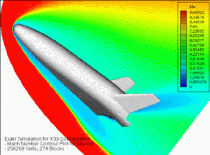
|
A new generation of space transportation vehicles is being designed and built in Europe, the U.S., and in Japan to reduce space transportation cost by an order of magnitude. In cooperation withESTEC (European Space Agency) and Daimler-Benz Aerospace (DASA), Germany activities are carried out under Europe's Future European Space Transportation Investigation Program (FESTIP) to investigate the validity of a Single-Stage-To-Orbit vehicle like the U.S. X-33, using high performance computing.I have received funding for this activity from the Ministry of Science and Culture, Lower Saxony, Germany, and my main effort is directed towards the integration of the department's research into FESTIP and providing to both ESA and Daimler-Benz Aerospace the necessary aerodynamic design results for an SSTO configuration, advancing the state-of-art of aerodynamic design tools in grid generation, CFD, and parallel computing. This work is funded by the Ministerium für Wissenschaft und Kultur, Niedersachsen, Deutschland. |
| Aerodynamic Analysis System (AAS), European Space Agency | |
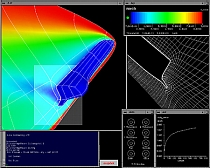
|
The department is a subcontractor on AAS phase two that is an effort of Europe's aerospace industry to obtain a rapid aerodynamic design system, initiated and funded by ESTEC (European Space Agency). Our contribution will be in the design of 3D multiblock GridPro grids and providing a tool tor conversion of IGES CAD data into a surface description that can be used by the grid generation code. |
| Parallel Computational Fluid Dynamics | |
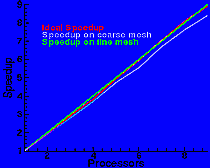
|
The plot shows an almost ideal parallel speedup for the 10 processor SGI Power Challenge used to compute a Mach 9.8 Euler solution on a 280 block mesh using some 900,000 points for the CLE generated Single Stage To Orbit vehicle. The Tangled Web approach has been used to achieve both parallel and numerical scalability. The ParNSS code utilized for this computation has also been implemented on CACR Caltech HP Exemplar and Beowolf parallel machines. |
| Threedimensional Grid Generation for Highly Complex Configurations | |

|
Substantial effort of my work has been directed to grid generation algorithms for complex threedimensional geometries, related to scientific and engineering applications on high performance architecture. In the past I have worked with structural mechanics, reservoir simulation, physics, and fluid dynamics applications. Currently at NERSC I am interested in applications of eigenvalue techniques to computational chemistry and biology. |
| Professional Activities | |

|
There are several journals for which I serve as a referee. There are always at least one or two conferences, where I am on an organizing, steering, or technical committee. (The image links to the 6th Numerical Grid Generation Conference, 6-9 July, 1998, London). I am a Senior Member of the American Institute of Aeronautics and Astronautics (AIAA) and a member of Deutsche Gesellschaft fur Luft-und Raumfahrt . |
| Teaching Activities | |
| Aerodynamics | |
|
is a one-semester undergraduate class on the foundation of aerodynamics, covering Anderson's John D. Anderson's well known text "Introduction to Flight".
|
|
| Advanced Aerodynamics | |
|
is a one-semester graduate course, covering the contents of John D. Anderson's text "Modern Compressible Flow" and gives an introduction on Magnetohydrodynamics
|
|
| Physics for Modern Technology | |
| covers the content of J. W. Rohlf's Modern Physics from a to Z0 | |
| Books/Proceedings (CoEditor), Papers and Talks: | |
| see Publications | |
| Biographical Sketch: | |
|
In 2004 Dr. Häuser was appointed member of the Technical Committee of Future Flight at the American Intitute of Aeronautics and Astronautics.
Since 1993, Dr. Häuser is a Professor of Computer Science and Parallel Computing at the University of Applied Sciences, Braunschweig-Wolfenbuettel, Germany and also Head of the Parallel Computing Department at the Center of Logistics and Expert Systems ( CLE ), Salzgitter, Germany. He also is a consultant to the European Space Agency in the field of aerodynamic simulation and high performance computing. In 1999 Professor Häuser spent his sabbatical year at the Seminar of Applied Mathematics at the Eidgenössische Technische Hochschule Zürich (Swiss Federal Institute of Technology), Switzerland, teaching High Performance Computing and Communications based on Java. From 1988 - 1992, Häuser was the Head of the Aerothermodynamics Section at the European Space Research and Technology Centre (ESTEC), Noordwijk, The Netherlands of the European Space Agency. From 1985-87 he was Professor of Computer Science at the Technical College of Landshut, Germany . From 1976 - 1984 he was a research scientist leading a research group in environmental fluid dynamics, CFD, and numerical grid generation. Dr. Häuser's research interests are in the development of algorithms for grid generation for complex geometries as well as high performance algorithms for parallel architectures in the area of Computational Fluid Dynamics. Particular areas of interest are numerical acceleration schemes , and domain decomposition algorithms for structured multiblock domains for parallel processing. Dr. Häuser's algorithm research efforts were honored with a Nato Scientific Affairs Divisionl Award (1984) for environmental flow simulation and the NASA distinguished lectureship (1991). |